An In-Vitro Study to Evaluate the Effect of Denture Cleansing Agents on Color Stability of Denture Bases Fabricated Using CAD/CAM Milling, 3D-Printing and Conventional Techniques
Abstract
:1. Introduction
2. Materials and Methods
2.1. Materials
2.2. Specimen Preparation
2.2.1. CAD/CAM Additive (3D Printing) Group
2.2.2. CAD/CAM Subtractive (Milling) Group
2.2.3. Injection Molded Group
2.2.4. Conventional Heat Cure Compression Molding Group
2.3. Finishing and Polishing of Specimens
2.4. Initial Color Testing
2.5. Immersion Procedures
- Subgroup A: Control group (distilled water).
- Subgroup B: Polident 3 min daily denture cleanser.
- Subgroup C: Fixodent Plus Scope denture cleanser.
2.6. Final Color Testing
2.7. Data Analysis
3. Results
4. Discussion
- The buffering action of saliva, staining from food ingredients, and the effects of temperature change could not be replicated in this in vitro study. Further studies could be conducted using denture bases used by patients;
- The present study only evaluated the effect of the chemical method of cleansing on the denture base materials, for six months. Further studies could be conducted wherein chemical methods are combined with mechanical cleaning methods, and for longer duration;
- Lastly, the present study only tested the color change. The effect of the denture cleanser on other important aspects, such as surface roughness, gloss, surface hardness, and flexural strength could also be investigated. Additional clinical studies using denture cleansers of different compositions should also be conducted on these new denture base materials.
5. Conclusions
- There was a significant change in color in all the denture base resins fabricated using different techniques after immersion in denture cleanser solutions. However, the ∆E00 values were far below the clinically acceptable range for all four denture base resins;
- Both the Polident and Fixodent denture cleansers gave rise to the highest ∆E00 values for the CAD/CAM milled denture base resins;
- The CAD/CAM additive (3D printed) denture base resins showed the lowest ∆E00 values when immersed in the Polident denture cleanser, and the second-lowest values when immersed in the Fixodent denture cleanser;
- The ∆E00 values of injection-molded denture base resins were lower compared to the conventional heat-polymerized resins for both the denture cleanser solutions;
- The extent of color change varied according to the type of denture cleanser used. The ∆E00 values were higher with Polident compared to Fixodent for all the denture base resins.
Author Contributions
Funding
Institutional Review Board Statement
Informed Consent Statement
Data Availability Statement
Conflicts of Interest
References
- Commission of Oral Health; Research and Epidemiology Report of a Working Group Oral health needs of the elderly--an international review. Commission of Oral Health, Research and Epidemiology Report of a Working Group. Int. Dent. J. 1993, 43, 348–354. [Google Scholar]
- Bidra, A.S.; Taylor, T.D.; Agar, J.R. Computer-aided technology for fabricating complete dentures: Systematic review of historical background, current status, and future perspectives. J. Prosthet. Dent. 2013, 109, 361–366. [Google Scholar] [CrossRef]
- Kattadiyil, M.T.; Jekki, R.; Goodacre, C.J.; Baba, N.Z. Comparison of treatment outcomes in digital and conventional complete removable dental prosthesis fabrications in a predoctoral setting. J. Prosthet. Dent. 2015, 114, 818–825. [Google Scholar] [CrossRef]
- Srinivasan, M.; Kalberer, N.; Naharro, M.; Marchand, L.; Lee, H.; Müller, F. CAD-CAM milled dentures: The Geneva protocols for digital dentures. J. Prosthet. Dent. 2020, 123, 27–37. [Google Scholar] [CrossRef] [Green Version]
- Schweiger, J.; Stumbaum, J.; Edelhoff, D.; Güth, J.-F. Systematics and concepts for the digital production of complete dentures: Risks and opportunities. Int. J. Comput. Dent. 2018, 21, 41–56. [Google Scholar]
- Millet, C.; Virard, F.; Dougnac-Galant, T.; Ducret, M. CAD-CAM immediate to definitive complete denture transition: A digital dental technique. J. Prosthet. Dent. 2020, 124, 642–646. [Google Scholar] [CrossRef] [PubMed]
- Lin, W.-S.; Harris, B.T.; Pellerito, J.; Morton, D. Fabrication of an interim complete removable dental prosthesis with an in-office digital light processing three-dimensional printer: A proof-of-concept technique. J. Prosthet. Dent. 2018, 120, 331–334. [Google Scholar] [CrossRef]
- Unkovskiy, A.; Wahl, E.; Zander, A.T.; Huettig, F.; Spintzyk, S. Intraoral scanning to fabricate complete dentures with functional borders: A proof-of-concept case report. BMC Oral Health 2019, 19, 46. [Google Scholar] [CrossRef] [PubMed] [Green Version]
- Cristache, C.M.; Totu, E.E.; Iorgulescu, G.; Pantazi, A.; Dorobantu, D.; Nechifor, A.C.; Isildak, I.; Burlibasa, M.; Nechifor, G.; Enachescu, M. Eighteen Months Follow-Up with Patient-Centered Outcomes Assessment of Complete Dentures Manufactured Using a Hybrid Nanocomposite and Additive CAD/CAM Protocol. J. Clin. Med. 2020, 9, 324. [Google Scholar] [CrossRef] [PubMed] [Green Version]
- Srinivasan, M.; Gjengedal, H.; Cattani-Lorente, M.; Moussa, M.; Durual, S.; Schimmel, M.; Müller, F. CAD/CAM milled complete removable dental prostheses: An in vitro evaluation of biocompatibility, mechanical properties, and surface roughness. Dent. Mater. J. 2018, 37, 526–533. [Google Scholar] [CrossRef] [Green Version]
- Alp, G.; Murat, S.; Yilmaz, B. Comparison of Flexural Strength of Different CAD/CAM PMMA-Based Polymers. J. Prosthodont. 2019, 28, E491–E495. [Google Scholar] [CrossRef] [PubMed]
- Arslan, M.; Murat, S.; Alp, G.; Zaimoglu, A. Evaluation of flexural strength and surface properties of prepolymerized CAD/CAM PMMA-based polymers used for digital 3D complete dentures. Int. J. Comput. Dent. 2018, 21, 31–40. [Google Scholar] [PubMed]
- Alammari, M.R. The influence of polishing techniques on pre-polymerized CAD\CAM acrylic resin denture bases. Electron. Physician 2017, 9, 5452–5458. [Google Scholar] [CrossRef] [PubMed] [Green Version]
- Al-Dwairi, Z.N.; Tahboub, K.Y.; Baba, N.Z.; Goodacre, C.J.; Özcan, M. A Comparison of the Surface Properties of CAD/CAM and Conventional Polymethylmethacrylate (PMMA). J. Prosthodont. 2019, 28, 452–457. [Google Scholar] [CrossRef] [PubMed] [Green Version]
- Steinmassl, O.; Dumfahrt, H.; Grunert, I.; Steinmassl, P.-A. Influence of CAD/CAM fabrication on denture surface properties. J. Oral Rehab. 2018, 45, 406–413. [Google Scholar] [CrossRef] [Green Version]
- Murakami, N.; Wakabayashi, N.; Matsushima, R.; Kishida, A.; Igarashi, Y. Effect of high-pressure polymerization on mechanical properties of PMMA denture base resin. J. Mech. Behav. Biomed. Mater. 2013, 20, 98–104. [Google Scholar] [CrossRef]
- Nogueira, S.S.; Ogle, R.E.; Davis, E.L. Comparison of accuracy between compression- and injection-molded complete dentures. J. Prosthet. Dent. 1999, 82, 291–300. [Google Scholar] [CrossRef]
- Paranhos, H.F.O.; Silva-Lovato, C.H.; Souza, R.F.; Cruz, P.C.; Freitas, K.M.; Peracini, A. Effects of mechanical and chemical methods on denture biofilm accumulation. J. Oral Rehabil. 2007, 34, 606–612. [Google Scholar] [CrossRef] [PubMed]
- Saraç, D.; Saraç, Y.S.; Kurt, M.; Yüzbaşioğlu, E. The effectiveness of denture cleansers on soft denture liners colored by food colorant solutions. J. Prosthodont. 2007, 16, 185–191. [Google Scholar] [CrossRef]
- Robinson, J.G.; McCabe, J.F.; Storer, R. Denture bases: The effects of various treatments on clarity, strength and structure. J. Dent. 1987, 15, 159–165. [Google Scholar] [CrossRef]
- Berger, J.C.; Driscoll, C.F.; Romberg, E.; Luo, Q.; Thompson, G. Surface roughness of denture base acrylic resins after processing and after polishing. J. Prosthodont. 2006, 15, 180–186. [Google Scholar] [CrossRef] [PubMed]
- Peracini, A.; Davi, L.R.; de Queiroz Ribeiro, N.; de Souza, R.F.; da Silva, C.H.L.; de Freitas Oliveira Paranhos, H. Effect of denture cleansers on physical properties of heat-polymerized acrylic resin. J. Prosthodont. Res. 2010, 54, 78–83. [Google Scholar] [CrossRef] [PubMed]
- Ozyilmaz, O.Y.; Kara, O.; Akin, C. Evaluation of various denture cleansers on color stability and surface topography of polyetherketoneketone, polyamide, and polymethylmethacrylate. Microsc. Res. Tech. 2021, 84, 3–11. [Google Scholar] [CrossRef] [PubMed]
- Zidan, S.; Silikas, N.; Haider, J.; Yates, J. Effect of Cleansers on the Colour Stability of Zirconia Impregnated PMMA Bio-Nanocomposite. Nanomaterials 2020, 10, 1757. [Google Scholar] [CrossRef]
- Lee, Y.-K.; Lim, B.-S.; Kim, C.-W. Influence of illuminating and viewing aperture size on the color of dental resin composites. Dent. Mater. 2004, 20, 116–123. [Google Scholar] [CrossRef]
- Shotwell, J.L.; Razzoog, M.E.; Koran, A. Color stability of long-term soft denture liners. J. Prosthet. Dent. 1992, 68, 836–838. [Google Scholar] [CrossRef]
- Canay, S.; Hersek, N.; Tulunoğlu, I.; Uzun, G. Evaluation of colour and hardness changes of soft lining materials in food colorant solutions. J. Oral Rehab. 1999, 26, 821–829. [Google Scholar] [CrossRef] [PubMed]
- Hada, T.; Kanazawa, M.; Iwaki, M.; Arakida, T.; Soeda, Y.; Katheng, A.; Otake, R.; Minakuchi, S. Effect of Printing Direction on the Accuracy of 3D-Printed Dentures Using Stereolithography Technology. Materials 2020, 13, 3405. [Google Scholar] [CrossRef] [PubMed]
- Gruber, S.; Kamnoedboon, P.; Özcan, M.; Srinivasan, M. CAD/CAM Complete Denture Resins: An In Vitro Evaluation of Color Stability. J. Prosthodont. 2021, 30, 430–439. [Google Scholar] [CrossRef]
- Uchida, H.; Vaidyanathan, J.; Viswanadhan, T.; Vaidyanathan, T.K. Color stability of dental composites as a function of shade. J. Prosthet. Dent. 1998, 79, 372–377. [Google Scholar] [CrossRef]
- Ma, T.; Johnson, G.H.; Gordon, G.E. Effects of chemical disinfectants on the surface characteristics and color of denture resins. J. Prosthet. Dent. 1997, 77, 197–204. [Google Scholar] [CrossRef]
- Luo, M.; Cui, G.; Rigg, B. The development of the CIE 2000 colour-difference formula: CIEDE2000. Color Res. Appl. 2001, 26, 340–350. [Google Scholar] [CrossRef]
- Gómez-Polo, C.; Montero, J.; Gómez-Polo, M.; Martin Casado, A. Comparison of the CIELab and CIEDE 2000 Color Difference Formulas on Gingival Color Space. J. Prosthodont. 2020, 29, 401–408. [Google Scholar] [CrossRef]
- Hong, G.; Murata, H.; Li, Y.; Sadamori, S.; Hamada, T. Influence of denture cleansers on the color stability of three types of denture base acrylic resin. J. Prosthet. Dent. 2009, 101, 205–213. [Google Scholar] [CrossRef]
- Polyzois, G.; Niarchou, A.; Ntala, P.; Pantopoulos, A.; Frangou, M. The effect of immersion cleansers on gloss, colour and sorption of acetal denture base material. Gerodontology 2013, 30, 150–156. [Google Scholar] [CrossRef]
- Polychronakis, N.C.; Polyzois, G.L.; Lagouvardos, P.E.; Papadopoulos, T.D. Effects of cleansing methods on 3-D surface roughness, gloss and color of a polyamide denture base material. Acta Odontol. Scand. 2015, 73, 353–363. [Google Scholar] [CrossRef]
- Iazzetti, G.; Burgess, J.O.; Gardiner, D.; Ripps, A. Color stability of fluoride-containing restorative materials. Oper. Dent. 2000, 25, 520–525. [Google Scholar]
- Hersek, N.; Canay, S.; Uzun, G.; Yildiz, F. Color stability of denture base acrylic resins in three food colorants. J. Prosthet. Dent. 1999, 81, 375–379. [Google Scholar] [CrossRef]
- Arima, T.; Murata, H.; Hamada, T. Properties of highly cross-linked autopolymerizing reline acrylic resins. J. Prosthet. Dent. 1995, 73, 55–59. [Google Scholar] [CrossRef]
- Arima, T.; Murata, H.; Hamada, T. Analysis of composition and structure of hard autopolymerizing reline resins. J. Oral Rehab. 1996, 23, 346–352. [Google Scholar] [CrossRef]
- Truong, V.T.; Thomasz, F.G. Comparison of denture acrylic resins cured by boiling water and microwave energy. Aust. Dent. J. 1988, 33, 201–204. [Google Scholar] [CrossRef]
- Nikawa, H.; Hamada, T.; Yamashiro, H.; Kumagai, H. A review of in vitro and in vivo methods to evaluate the efficacy of denture cleansers. Int. J. Prosthodont. 1999, 12, 153–159. [Google Scholar] [PubMed]
- Nikawa, H.; Iwanaga, H.; Hamada, T.; Yuhta, S. Effects of denture cleansers on direct soft denture lining materials. J. Prosthet. Dent. 1994, 72, 657–662. [Google Scholar] [CrossRef]
- Okubo, S.R.; Kanawati, A.; Richards, M.W.; Childress, S. Evaluation of visual and instrument shade matching. J. Prosthet. Dent. 1998, 80, 642–648. [Google Scholar] [CrossRef]
- Chang, J.; Da Silva, J.D.; Sakai, M.; Kristiansen, J.; Ishikawa-Nagai, S. The optical effect of composite luting cement on all ceramic crowns. J. Dent. 2009, 37, 937–943. [Google Scholar] [CrossRef]
- Brewer, J.D.; Wee, A.; Seghi, R. Advances in color matching. Dent. Clin. N. Am. 2004, 48, 341–358. [Google Scholar] [CrossRef] [PubMed]
- Wee, A.G.; Lindsey, D.T.; Shroyer, K.M.; Johnston, W.M. Use of a porcelain color discrimination test to evaluate color difference formulas. J. Prosthet. Dent. 2007, 98, 101–109. [Google Scholar] [CrossRef] [Green Version]
- Gómez-Polo, C.; Portillo Muñoz, M.; Lorenzo Luengo, M.C.; Vicente, P.; Galindo, P.; Martín Casado, A.M. Comparison of two color-difference formulas using the Bland-Altman approach based on natural tooth color space. J. Prosthet. Dent. 2016, 115, 482–488. [Google Scholar] [CrossRef]
- Mokrzycki, W.S.; Tatol, M. Color difference ΔE—A survey. Mach. Graph. Vis. 2011, 20, 383–411. [Google Scholar]
- Ren, J.; Lin, H.; Huang, Q.; Zheng, G. Determining color difference thresholds in denture base acrylic resin. J. Prosthet. Dent. 2015, 114, 702–708. [Google Scholar] [CrossRef]
- Paravina, R.D.; Ghinea, R.; Herrera, L.J.; Bona, A.D.; Igiel, C.; Linninger, M.; Sakai, M.; Takahashi, H.; Tashkandi, E.; Perez, M. Color difference thresholds in dentistry. J. Esthet. Restor. Dent. 2015, 27, S1–S9. [Google Scholar] [CrossRef] [PubMed]
- Pérez, M.M.; Ghinea, R.; Herrera, L.J.; Carrillo, F.; Ionescu, A.M.; Paravina, R.D. Color difference thresholds for computer-simulated human Gingiva. J. Esthet. Restor. Dent. 2018, 30, E24–E30. [Google Scholar] [CrossRef] [PubMed]
- Coimbra, F.C.T.; Rocha, M.M.; Oliveira, V.C.; Macedo, A.P.; Pagnano, V.O.; Silva-Lovato, C.H.; Paranhos, H.d.F.O. Antimicrobial activity of effervescent denture tablets on multispecies biofilms. Gerodontology 2021, 38, 87–94. [Google Scholar] [CrossRef] [PubMed]
- Ayaz, E.A.; Altintas, S.H.; Turgut, S. Effects of cigarette smoke and denture cleaners on the surface roughness and color stability of different denture teeth. J. Prosthet. Dent. 2014, 112, 241–248. [Google Scholar] [CrossRef]
- Elshereksi, N.W.; Ghazali, M.J.; Muchtar, A.; Azhari, C.H. Perspectives for titanium-derived fillers usage on denture base composite construction: A review article. Adv. Mater. Sci. Eng. 2014, 2014, 13. [Google Scholar] [CrossRef] [Green Version]
- Robinson, J.G.; McCabe, J.F.; Storer, R. The whitening of acrylic dentures: The role of denture cleansers. Br. Dent. J. 1985, 159, 247–250. [Google Scholar] [CrossRef]
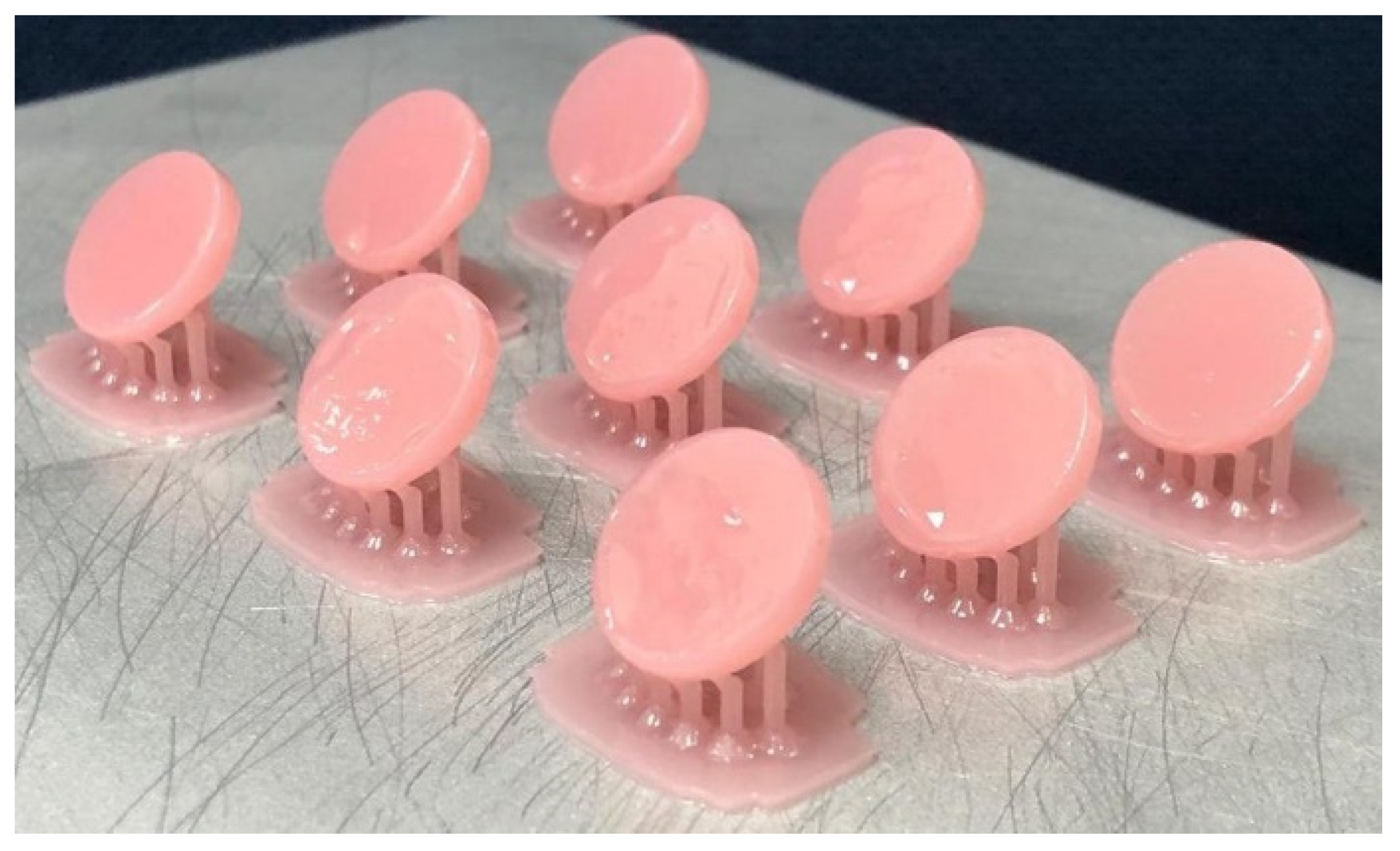
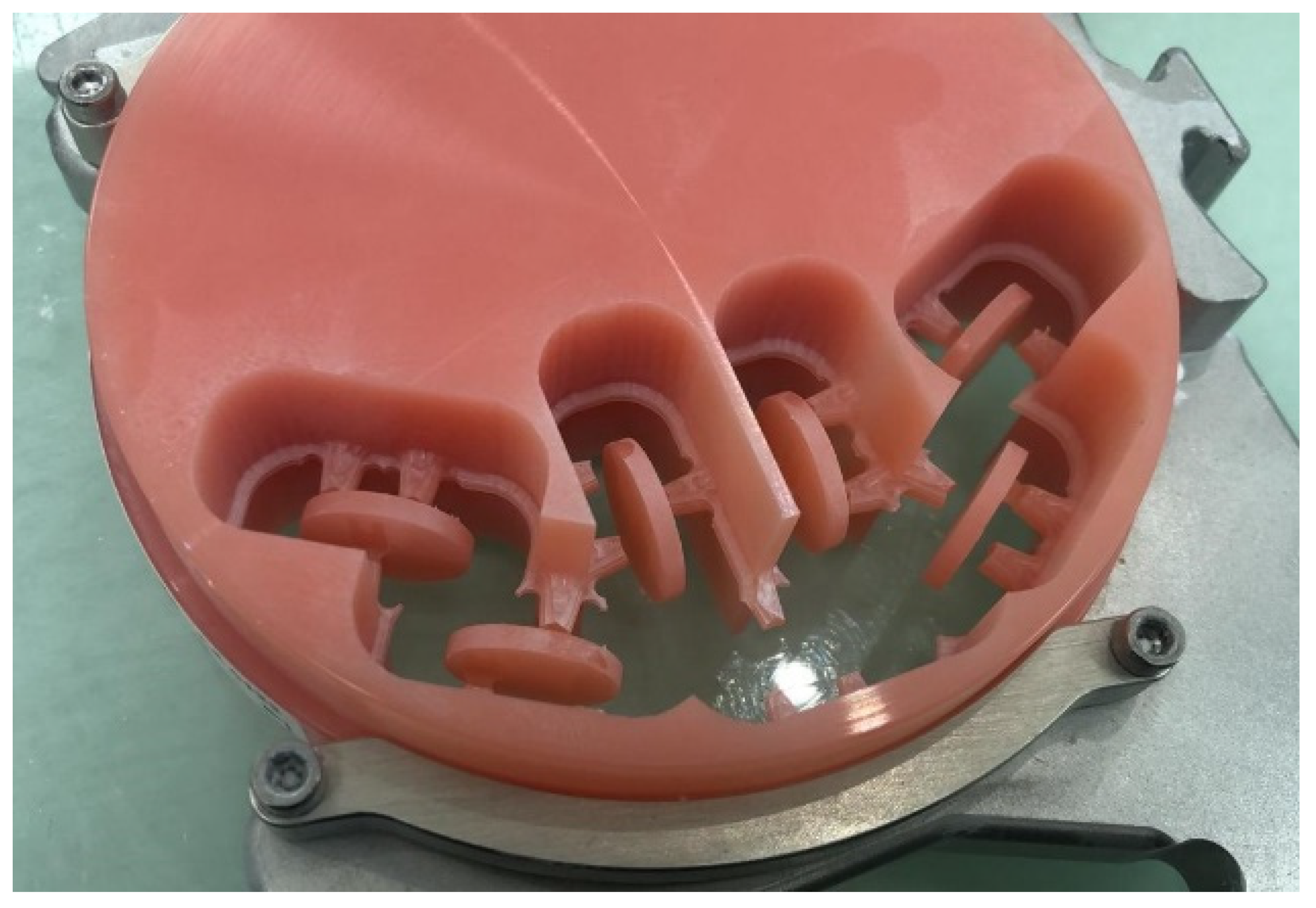
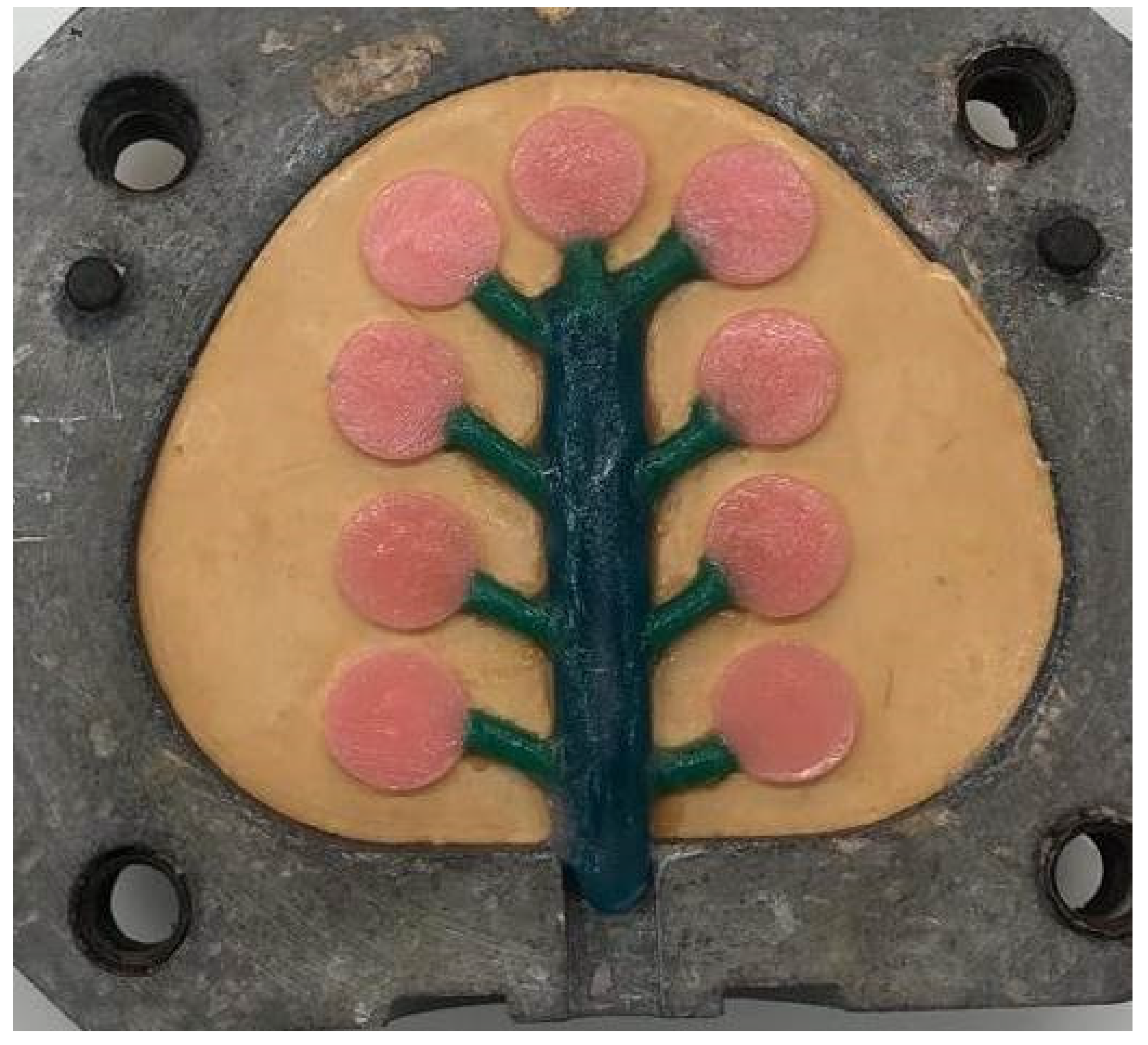
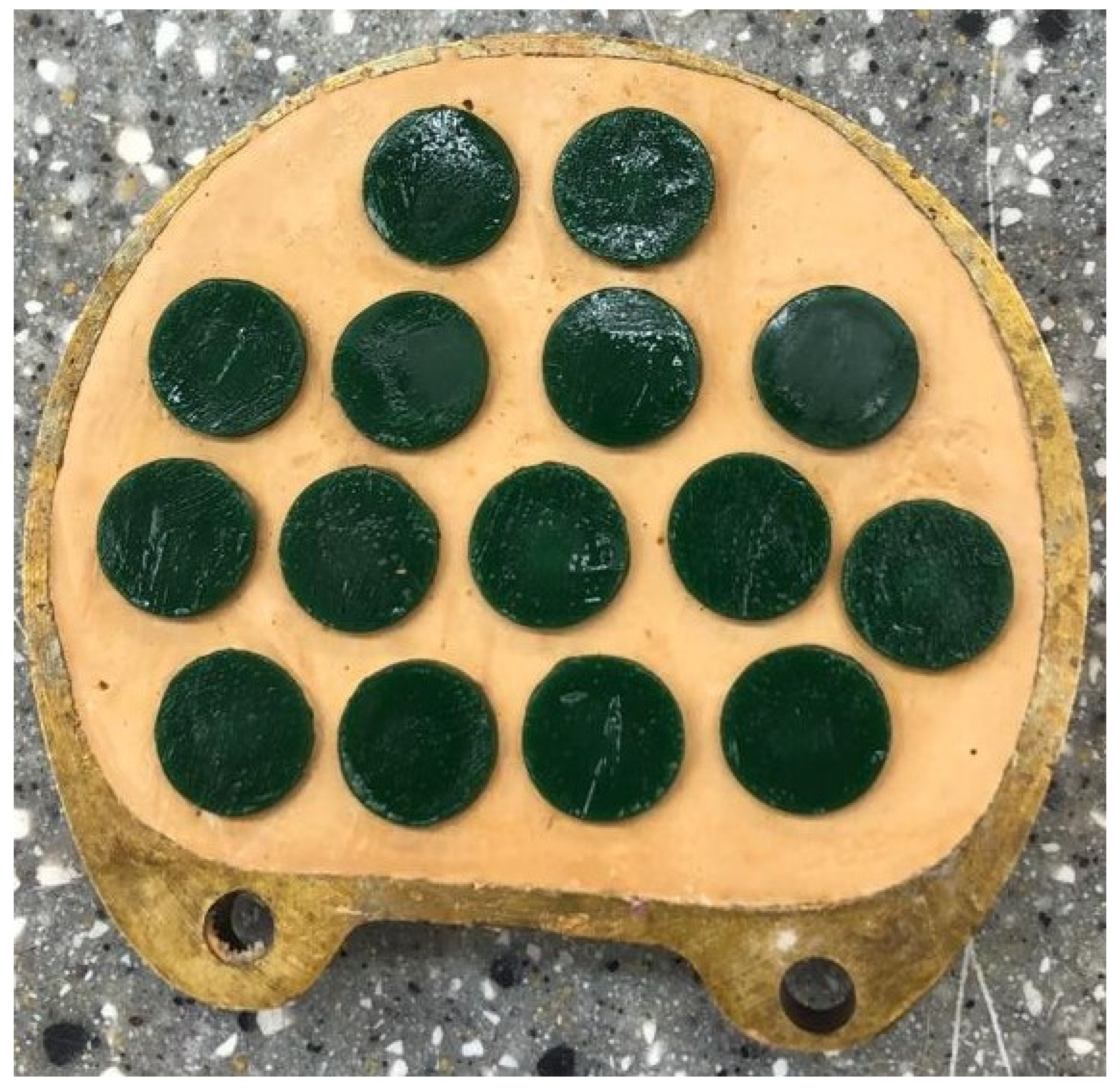
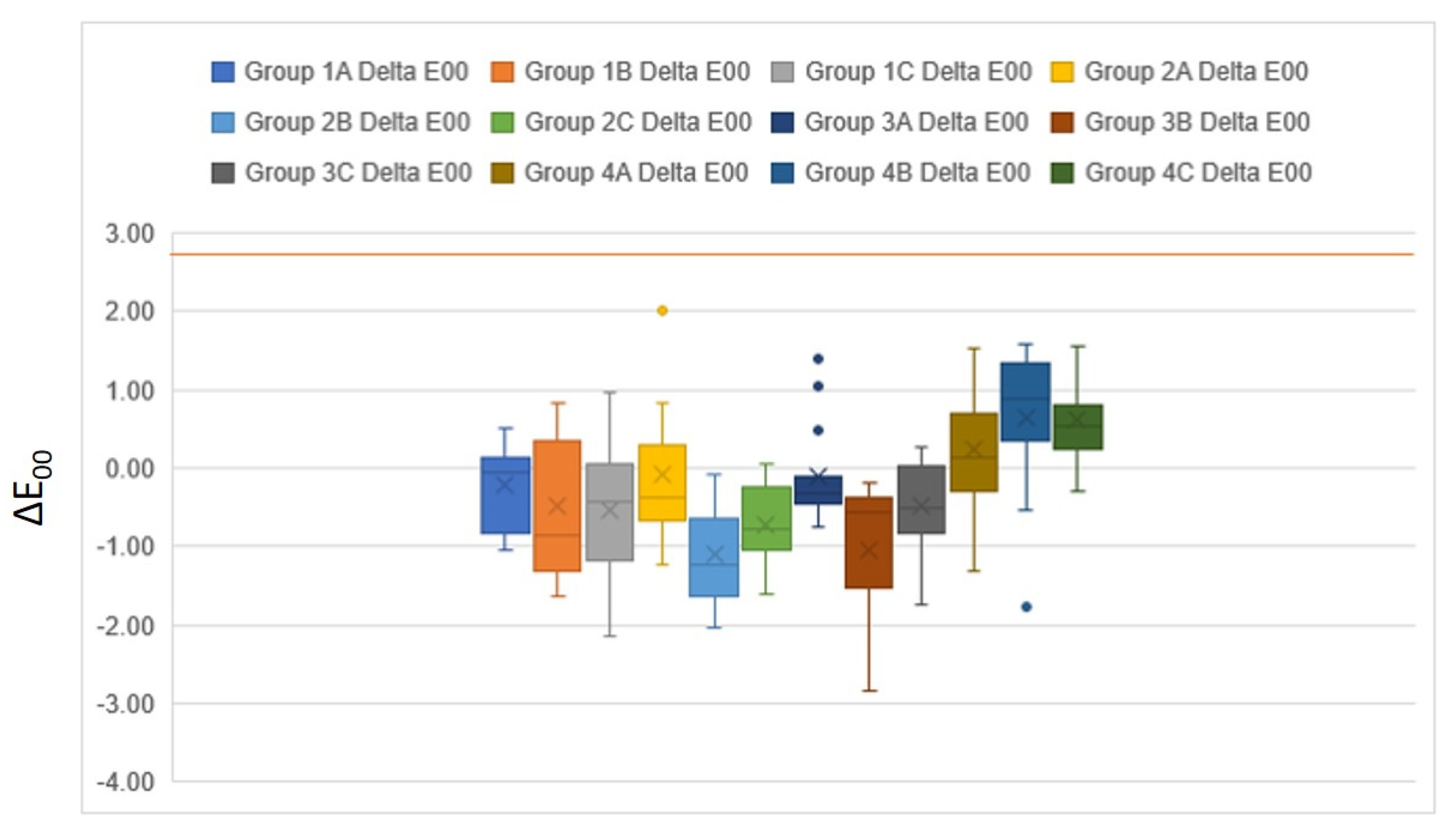
| Denture Base Resin | ||||||
|---|---|---|---|---|---|---|
| Group | Material Trade Name | Batch Number | Manufacturer | Main Composition | Polymerization | Fabrication Technique |
| Group 1 | NextDent Denture 3D+ | WY032N01 | Vertex-Dental, Soesterberg, The Netherlands | Dimethacrylate-based resins with photo-initiator, filler, and pigments. | Light-cured resin | CAD/CAM additive manufacturing, 3D printing (NextDent™ 5100 Figure 4 3D printer) |
| Group 2 | Wieland | UP0897 | Wieland Dental + Technik GmbH and Co. KG, Pforzheim, Germany | PMMA resin | Pre-polymerized | CAD/CAM subtractive manufacturing, milling technique (Opera Pro-Expert 5) |
| Group 3 | Bre. flex | 402114 | Bredent GmbH & Co. KG, Senden, Germany | Pure polyamide | Thermoplastic heat polymerized resin | Injection molding technique (Thermopress 400 system 2.62) |
| Group 4 | Meliodent | K010028 | Kulzer-GmbH, Hanau, Germany | Polymethylmethacrylate, benzoyl peroxide, methyl methacrylate, ethylene glycol dimethacrylate | Heat polymerized resin | Compression molding, heat polymerizing technique |
| Denture Cleanser | ||||||
| Material Trade Name | Batch Number | Manufacturer | Main Ingredients | Recommended Soaking Time | ||
| Group B | Polident 3 min daily cleaner Tablet | W84M | GSK Consumer Healthcare, Warren, NJ, USA | Sodium bicarbonate, citric acid, Potassium monopersulfate, sodium carbonate, sodium carbonate peroxide, TAED, Sodium Benzoate, PEG-180, sodium lauryl sulfate, VP/VA copolymer, flavor, cellulose gum, FD&C blue 2, blue 1 lake, yellow 5, yellow 5 lake. | 3 min in warm water | |
| Group C | Fixodent Plus Scope tablet | 9347D0001N | Procter & Gamble, Cincinnati, OH, USA | Sodium carbonate peroxide, citric acid, sodium sulfate, potassium monopersulfate, sodium bicarbonate, sodium carbonate, PVP, lactose, PEG-150, sodium lauryl sulfate, isopropyl alcohol, flavor | 3–5 min in warm water | |
| Group | Subgroup | N | ΔE00 | Intergroup Comparison (ΔE00) | |
|---|---|---|---|---|---|
| Mean | SD | ||||
| Group 1 | Solution A | 15 | −0.22 | 0.53 | Group 1 vs. 2 vs. 3 vs. 4 a = 0.001 * Group 1 vs. 2 b =0.001 * Group 1 vs. 3 b = 0.001 * Group 1 vs. 4 b = 0.001 * Group 2 vs. 3 b = 0.006 * Group 2 vs. 4 b = 0.002 * Group 3 vs. 4 b = 0.001 * |
| Solution B | 15 | −0.48 | 0.88 | ||
| Solution C | 15 | −0.54 | 0.93 | ||
| Group 2 | Solution A | 15 | −0.09 | 0.83 | |
| Solution B | 15 | −1.10 | 0.57 | ||
| Solution C | 15 | −0.72 | 0.46 | ||
| Group 3 | Solution A | 15 | −0.12 | 0.62 | |
| Solution B | 15 | −1.04 | 0.85 | ||
| Solution C | 15 | −0.47 | 0.59 | ||
| Group 4 | Solution A | 15 | 0.23 | 0.77 | |
| Solution B | 15 | 0.65 | 0.89 | ||
| Solution C | 15 | 0.61 | 0.52 | ||
| Source | Type III Sum of Squares | df | Mean Square | F | Sig. | |
|---|---|---|---|---|---|---|
| Intercept | Hypothesis | 29.099 | 1 | 29.099 | 27.757 | 0.001 |
| Error | 9.372 | 8.940 | 1.048 (a) | - | - | |
| GROUP | Hypothesis | 18.092 | 1 | 18.092 | 27.114 | 0.000 |
| Error | 117.437 | 176 | 0.667 (b) | - | - | |
| SOLUTION | Hypothesis | 5.908 | 2 | 2.954 | 4.427 | 0.013 |
| Error | 117.437 | 176 | 0.667 (b) | - | - | |
| Surface Roughness | Group | Solution A | Solution B | Solution C |
|---|---|---|---|---|
| ΔSa (μm) | Group 1 | −0.010 ± 0.019 | 0.071 ± 0.012 | 0.170 ± 0.019 |
| Group 2 | −0.007 ± 0.006 | 0.039 ± 0.006 | 0.110 ± 0.025 | |
| Group 3 | −0.009 ± 0.005 | 0.043 ± 0.008 | 0.122 ± 0.022 | |
| Group 4 | −0.012 ± 0.004 | 0.054 ± 0.010 | 0.143 ± 0.014 |
Publisher’s Note: MDPI stays neutral with regard to jurisdictional claims in published maps and institutional affiliations. |
© 2021 by the authors. Licensee MDPI, Basel, Switzerland. This article is an open access article distributed under the terms and conditions of the Creative Commons Attribution (CC BY) license (https://creativecommons.org/licenses/by/4.0/).
Share and Cite
Jain, S.; Sayed, M.; Ahmed, W.M.; Halawi, A.H.A.; Najmi, N.M.A.; Aggarwal, A.; Bhandi, S.; Patil, S. An In-Vitro Study to Evaluate the Effect of Denture Cleansing Agents on Color Stability of Denture Bases Fabricated Using CAD/CAM Milling, 3D-Printing and Conventional Techniques. Coatings 2021, 11, 962. https://doi.org/10.3390/coatings11080962
Jain S, Sayed M, Ahmed WM, Halawi AHA, Najmi NMA, Aggarwal A, Bhandi S, Patil S. An In-Vitro Study to Evaluate the Effect of Denture Cleansing Agents on Color Stability of Denture Bases Fabricated Using CAD/CAM Milling, 3D-Printing and Conventional Techniques. Coatings. 2021; 11(8):962. https://doi.org/10.3390/coatings11080962
Chicago/Turabian StyleJain, Saurabh, Mohammed Sayed, Walaa Magdy Ahmed, Amjad Hussain Asiri Halawi, Naif Mohammed Ahmed Najmi, Aparna Aggarwal, Shilpa Bhandi, and Shankargouda Patil. 2021. "An In-Vitro Study to Evaluate the Effect of Denture Cleansing Agents on Color Stability of Denture Bases Fabricated Using CAD/CAM Milling, 3D-Printing and Conventional Techniques" Coatings 11, no. 8: 962. https://doi.org/10.3390/coatings11080962
APA StyleJain, S., Sayed, M., Ahmed, W. M., Halawi, A. H. A., Najmi, N. M. A., Aggarwal, A., Bhandi, S., & Patil, S. (2021). An In-Vitro Study to Evaluate the Effect of Denture Cleansing Agents on Color Stability of Denture Bases Fabricated Using CAD/CAM Milling, 3D-Printing and Conventional Techniques. Coatings, 11(8), 962. https://doi.org/10.3390/coatings11080962








